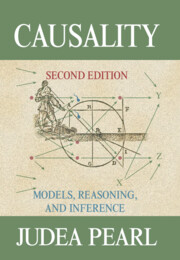Book contents
- Frontmatter
- Dedication
- Contents
- Preface to the First Edition
- Preface to the Second Edition
- 1 Introduction to Probabilities, Graphs, and Causal Models
- 2 A Theory of Inferred Causation
- 3 Causal Diagrams and the Identification of Causal Effects
- 4 Actions, Plans, and Direct Effects
- 5 Causality and Structural Models in Social Science and Economics
- 6 Simpson’s Paradox, Confounding, and Collapsibility
- 7 The Logic of Structure-Based Counterfactuals
- 8 Imperfect Experiments: Bounding Effects and Counterfactuals
- 9 Probability of Causation: Interpretation and Identification
- 10 The Actual Cause
- 11 Reflections, Elaborations, and Discussions with Readers
- Epilogue The Art and Science of Cause and Effect
- Bibliography
- Name Index
- Subject Index
11 - Reflections, Elaborations, and Discussions with Readers
Published online by Cambridge University Press: 05 March 2013
- Frontmatter
- Dedication
- Contents
- Preface to the First Edition
- Preface to the Second Edition
- 1 Introduction to Probabilities, Graphs, and Causal Models
- 2 A Theory of Inferred Causation
- 3 Causal Diagrams and the Identification of Causal Effects
- 4 Actions, Plans, and Direct Effects
- 5 Causality and Structural Models in Social Science and Economics
- 6 Simpson’s Paradox, Confounding, and Collapsibility
- 7 The Logic of Structure-Based Counterfactuals
- 8 Imperfect Experiments: Bounding Effects and Counterfactuals
- 9 Probability of Causation: Interpretation and Identification
- 10 The Actual Cause
- 11 Reflections, Elaborations, and Discussions with Readers
- Epilogue The Art and Science of Cause and Effect
- Bibliography
- Name Index
- Subject Index
Summary
As X-rays are to the surgeon, graphs are for causation.
The authorIn this chapter, I reflect back on the material covered in Chapters 1 to 10, discuss issues that require further elaboration, introduce new results obtained in the past eight years, and answer questions of general interest posed to me by readers of the first edition. These range from clarification of specific passages in the text, to conceptual and philosophical issues concerning the controversial status of causation, how it is taught in classrooms and how it is treated in textbooks and research articles.
The discussions follow roughly the order in which these issues are presented in the book, with section numbers indicating the corresponding chapters.
CAUSAL, STATISTICAL, AND GRAPHICAL VOCABULARY
Is the Causal–Statistical Dichotomy Necessary? Question to Author (from many readers)
Chapter 1 (Section 1.5) insists on a sharp distinction between statistical and causal concepts; the former are definable in terms of a joint distribution function (of observed variables), the latter are not. Considering that many concepts which the book classifies as “causal” (e.g., “randomization,” “confounding,” and “instrumental variables”) are commonly discussed in the statistical literature, is this distinction crisp? Is it necessary? Is it useful?
Author Answer
The distinction is crisp, necessary, and useful, and, as I tell audiences in all my lectures: “If you get nothing out of this lecture except the importance of keeping statistical and causal concepts apart, I would consider it a success.” Here, I would dare go even further:
“If I am remembered for no other contribution except for insisting on the causal–statistical distinction, I would consider my scientific work worthwhile.”
The distinction is embarrassingly crisp and simple, because it is based on the fundamental distinction between statics and kinematics. Standard statistical analysis, typified by regression, estimation, and hypothesis-testing techniques, aims to assess parameters of a static distribution from samples drawn of that distribution. With the help of such parameters, one can infer associations among variables, estimate the likelihood of past and future events, as well as update the likelihood of events in light of new evidence or new measurements. These tasks are managed well by standard statistical analysis so long as experimental conditions remain the same.
Information
- Type
- Chapter
- Information
- CausalityModels, Reasoning, and Inference, pp. 331 - 400Publisher: Cambridge University PressPrint publication year: 2009
Accessibility standard: Unknown
Why this information is here
This section outlines the accessibility features of this content - including support for screen readers, full keyboard navigation and high-contrast display options. This may not be relevant for you.Accessibility Information
- 1
- Cited by
